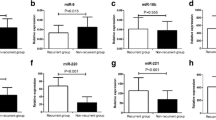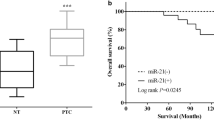Abstract
A growing body of evidence suggests a role of the von Hippel–Lindau (VHL) tumor suppressor gene in the progression of papillary thyroid carcinoma (PTC). Our previous study of VHL in PTCs showed that lower VHL expression was associated with aggressive tumor features, but we found no evidence for VHL downregulation through common genetic or epigenetic modifications. Several studies pointed to a role of microRNA-92a (miR-92a) in the regulation of VHL expression in different cancers. In the present study, we examined the expression levels of VHL mRNA and miR-92a in 42 pairs of PTCs and matched non-tumor thyroid tissues by means of quantitative RT-PCR. We explored the correlation between them and their association with clinicopathological parameters. The results revealed that both VHL and miR-92a were either up- or downregulated in PTCs compared to corresponding non-tumor tissues. On univariate analysis, lower VHL levels were significantly associated with extrathyroid spread (P = 0.022) and capsular invasion (P = 0.032). Multivariate analysis confirmed the association of low VHL with extrathyroid spread (OR 0.246, 95% CI 0.069–0.872, P = 0.038). Higher miR-92a among PTC tissues associated with the presence of nodal metastases (univariate analysis: P = 0.012; multivariate: OR 4.703, 95% CI 1.109–19.938, P = 0.036). A negative correlation between VHL and miR-92a was observed in a subgroup of PTCs having vascular invasion (P = 0.033, r = − 0.673). The data here reported demonstrate that the expression of both VHL and miR-92a is deregulated in PTC tissues and that in some PTCs they may have opposite roles. These roles, as well as their diagnostic and/or prognostic utility, remain to be clarified.


Similar content being viewed by others
References
LiVolsi VA. Papillary thyroid carcinoma: an update. Mod Pathol. 2011;24(Suppl 2):S1–9.
Pellegriti G, Frasca F, Regalbuto C, Squatrito S, Vigneri R. Worldwide Increasing Incidence of Thyroid Cancer: Update on Epidemiology and Risk Factors. Journal of Cancer Epidemiology, 2013: p. 1-10.
Eustatia-Rutten CF, Corssmit EP, Biermasz NR, Pereira AM, Romijn JA, Smit JW. Survival and death causes in differentiated thyroid carcinoma. J Clin Endocrinol Metab. 2006;91(1):313–9.
Schlumberger M, Cohen O, Duntas L, Jamar F, Jarzab B, Limbert E, et al. Follow-up of low-risk patients with differentiated thyroid carcinoma: a European perspective. Eur J Endocrinol. 2004;150(2):105–12.
Tuttle RM, Ball DW, Byrd D, Dilawari RA, Doherty GM, Duh QY, et al. Thyroid carcinoma. J Natl Compr Canc Netw. 2010;8(11):1228–74.
Omur O, Baran Y. An update on molecular biology of thyroid cancers. Crit Rev Oncol Hematol. 2014;90(3):233–52.
Xing M. BRAF mutation in papillary thyroid cancer: pathogenic role, molecular bases, and clinical implications. Endocr Rev. 2007;28(7):742–62.
Pacini F, Castagna MG, Brilli L, Pentheroudakis G. Thyroid cancer: ESMO Clinical Practice Guidelines for diagnosis, treatment and follow-up. Ann Oncol, 2012. 23 Suppl 7: p. vii110-9.
Baldini E, Sorrenti S, Tuccilli C, Prinzi N, Coccaro C, Catania A, et al. Emerging molecular markers for the prognosis of differentiated thyroid cancer patients. Int J Surg. 2014;12(Suppl 1):S52–6.
Maxwell PH, Wiesener MS, Chang GW, Clifford SC, Vaux EC, Cockman ME, et al. The tumour suppressor protein VHL targets hypoxia-inducible factors for oxygen-dependent proteolysis. Nature. 1999;399(6733):271–5.
Gossage L, Eisen T, Maher ER. VHL, the story of a tumour suppressor gene. Nat Rev Cancer. 2015;15(1):55–64.
Kim WY, Kaelin WG. Role of VHL gene mutation in human cancer. J Clin Oncol. 2004;22(24):4991–5004.
Giles RH, Lolkema MP, Snijckers CM, Belderbos M, van der Groep P, Mans DA, et al. Interplay between VHL/HIF1alpha and Wnt/beta-catenin pathways during colorectal tumorigenesis. Oncogene. 2006;25(21):3065–70.
Murria R, Palanca S, de Juan I, Egoavil C, Alenda C, García-Casado Z, et al. Methylation of tumor suppressor genes is related with copy number aberrations in breast cancer. Am J Cancer Res. 2015;5(1):375–85.
Hasegawa H, Kusumi Y, Asakawa T, Maeda M, Oinuma T, Furusaka T, et al. Expression of von Hippel-Lindau tumor suppressor protein (pVHL) characteristic of tongue cancer and proliferative lesions in tongue epithelium. BMC Cancer. 2017;17(1):381.
Koch CA, Brouwers FM, Vortmeyer AO, Tannapfel A, Libutti SK, Zhuang Z, et al. Somatic VHL gene alterations in MEN2-associated medullary thyroid carcinoma. BMC Cancer. 2006;6:131.
Stanojevic B, Saenko V, Todorovic L, Petrovic N, Nikolic D, Zivaljevic V, et al. Low VHL mRNA expression is associated with more aggressive tumor features of papillary thyroid carcinoma. PLoS ONE. 2014;9(12):e114511.
Acunzo M, Romano G, Wernicke D, Croce CM. MicroRNA and cancer—a brief overview. Adv Biol Regul. 2015;57:1–9.
Tetreault N, De Guire V. miRNAs: their discovery, biogenesis and mechanism of action. Clin Biochem. 2013;46(10–11):842–5.
Hayes J, Peruzzi PP, Lawler S. MicroRNAs in cancer: biomarkers, functions and therapy. Trends Mol Med. 2014;20(8):460–9.
Valera VA, Walter BA, Linehan WM, Merino MJ. Regulatory effects of microRNA-92 (miR-92) on VHL gene expression and the hypoxic activation of miR-210 in clear cell renal cell carcinoma. J Cancer. 2011;2:515–26.
Ghosh AK, Cimmino A, Taccioli C, Volinia S, Liu CG, Calin GA, et al. Aberrant regulation of pVHL levels by microRNA promotes the HIF/VEGF axis in CLL B cells. Blood. 2009;113(22):5568–74.
ABI, User Bulletin #2: Relative Quantitation of Gene Expression. 1997(updated 2001). http://www3.appliedbiosystems.com/cms/groups/mcb_support/documents/generaldocuments/cms_040980.pdf. Accessed January 2017.
Los M, Jansen GH, Kaelin WG, Lips CJ, Blijham GH, Voest EE. Expression pattern of the von Hippel-Lindau protein in human tissues. Lab Invest. 1996;75(2):231–8.
Hinze R, Boltze C, Meye A, Holzhausen HJ, Dralle H, Rath FW. Expression of the von Hippel-Lindau tumor suppressor gene in nonneoplastic and neoplastic lesions of the thyroid. Endocr Pathol. 2000;11(2):145–55.
Hunt JL, Yim JH, Tometsko M, Finkelstein SD, Swalsky P, Carty SE. Loss of heterozygosity of the VHL gene identifies malignancy and predicts death in follicular thyroid tumors. Surgery. 2003;134(6):1043–8.
Baldini E, Tuccilli C, Arlot-Bonnemains Y, Chesnel F, Sorrenti S, De Vito C, et al. Deregulated expression of VHL mRNA variants in papillary thyroid cancer. Mol Cell Endocrinol. 2017;443:121–7.
Zia MK, Rmali KA, Watkins G, Mansel RE, Jiang WG. The expression of the von Hippel-Lindau gene product and its impact on invasiveness of human breast cancer cells. Int J Mol Med. 2007;20(4):605–11.
Ma EG, Bai YF, Cao W, Cao Y, Huang YG, Cheng HC, An RH. Cytosine 5-hydroxymethylation regulates VHL gene expression in renal clear cell carcinoma. Oncotarget. 2017;8(38):63780–7.
Chen C, Zhou H, Liu X, Liu Z, Ma Q. Reduced expression of von Hippel-Lindau protein correlates with decreased apoptosis and high chondrosarcoma grade. J Bone Joint Surg Am. 2011;93(19):1833–40.
Ren C, Wang W, Han C, Chen H, Fu D, Luo Y, et al. Expression and prognostic value of miR-92a in patients with gastric cancer. Tumor Biol. 2016;37(7):9483–91.
Tan W, Li Y, Lim SG, Tan TM. miR-106b-25/miR-17-92 clusters: polycistrons with oncogenic roles in hepatocellular carcinoma. World J Gastroenterol. 2014;20(20):5962–72.
Zhao B, Zhu Y, Cui K, Gao J, Yu F, Chen L, et al. Expression and significance of PTEN and miR-92 in hepatocellular carcinoma. Mol Med Rep. 2013;7(5):1413–6.
Yu Y, Zhang Y, Zhang S. MicroRNA-92 regulates cervical tumorigenesis and its expression is upregulated by human papillomavirus-16 E6 in cervical cancer cells. Oncol Lett. 2013;6(2):468–74.
Al-Sheikh YA, Ghneim HK, Softa KI, Al-Jobran AA, Al-Obeed O, Mohamed MA, et al. Expression profiling of selected microRNA signatures in plasma and tissues of Saudi colorectal cancer patients by qPCR. Oncol Lett. 2016;11(2):1406–12.
Wang H, Ke C, Ma X, Zhao Q, Yang M, Zhang W, et al. MicroRNA-92 promotes invasion and chemoresistance by targeting GSK3β and activating Wnt signaling in bladder cancer cells. Tumor Biol. 2016;37(12):16295–304.
Jikuzono T, Kawamoto M, Yoshitake H, Kikuchi K, Akasu H, Ishikawa H, et al. The miR-221/222 cluster, miR-10b and miR-92a are highly upregulated in metastatic minimally invasive follicular thyroid carcinoma. Int J Oncol. 2013;42(6):1858–68.
Takakura S, Mitsutake N, Nakashima M, Namba H, Saenko VA, Rogounovitch T, et al. Oncogenic role of miR-17-92 cluster in anaplastic thyroid cancer cells. Cancer Sci. 2008;99(6):1147–54.
Smith L, Baxter EW, Chambers PA, Green CA, Hanby AM, Hughes TA, et al. Down-regulation of miR-92 in Breast epithelial cells and in normal but not tumour fibroblasts contributes to breast carcinogenesis. PLoS ONE. 2015;10(10):e0139698.
Manni I, Artuso S, Careccia S, Rizzo MG, Baserga R, Piaggio G, et al. The microRNA miR-92 increases proliferation of myeloid cells and by targeting p63 modulates the abundance of its isoforms. FASEB J. 2009;23(11):3957–66.
Ventura A, Young AG, Winslow MM, Lintault L, Meissner A, Erkeland SJ, et al. Targeted deletion reveals essential and overlapping functions of the miR-17 ~ 92 family of miRNA clusters. Cell. 2008;132(5):875–86.
Tili E, Michaille JJ, Liu CG, Alder H, Taccioli C, Volinia S, et al. GAM/ZFp/ZNF512B is central to a gene sensor circuitry involving cell-cycle regulators, TGFβ effectors, Drosha and microRNAs with opposite oncogenic potentials. Nucleic Acids Res. 2010;38(21):7673–88.
Al-Nakhle H, Burns PA, Cummings M, Hanby AM, Hughes TA, Satheesha S, et al. ERβ1 expression is regulated by miR-92 in breast cancer. Can Res. 2010;70(11):4778–84.
Zhang L, Huang J, Yang N, Greshock J, Megraw MS, Giannakakis A, et al. microRNAs exhibit high frequency genomic alterations in human cancer. Proc Natl Acad Sci USA. 2006;103(24):9136–41.
Wang L, Wu J, Xie C. miR-92a promotes hepatocellular carcinoma cells proliferation and invasion by FOXA2 targeting. Iran J Basic Med Sci. 2017;20(7):783–90.
Funding
This study was supported by the Ministry of Education, Science and Technological Development of the Republic of Serbia, Contract No. ON173049.
Author information
Authors and Affiliations
Corresponding author
Ethics declarations
Conflict of interest
The authors declare that they have no conflict of interest.
Rights and permissions
About this article
Cite this article
Todorović, L., Stanojević, B., Mandušić, V. et al. Expression of VHL tumor suppressor mRNA and miR-92a in papillary thyroid carcinoma and their correlation with clinical and pathological parameters. Med Oncol 35, 17 (2018). https://doi.org/10.1007/s12032-017-1066-3
Received:
Accepted:
Published:
DOI: https://doi.org/10.1007/s12032-017-1066-3




